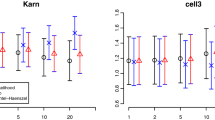Abstract
We consider graphs, confidence procedures and tests that can be used to compare transition probabilities in a Markov chain model with intensities specified by a Cox proportional hazard model. Under assumptions of this model, the regression coefficients provide information about the relative risks of covariates in one–step transitions, however, they cannot in general be used to to assess whether or not the covariates have a beneficial or detrimental effect on the endpoint events. To alleviate this problem, we consider graphical tests based on confidence procedures for a generalized Q–Q plot and for the difference between transition probabilities. The procedures are illustrated using data of the International Bone Marrow Transplant Registry.
Similar content being viewed by others
References
P. K. Andersen, O. Borgan, R. D. Gill, and N. Keiding, Statistical Models Based on Counting Processes, Springer Verlag: New York, 1993.
E. Arjas and M. Eerola, “On predictive causality in longitudinal studies,” J. Statist. Planning and Inference vol. 34 pp. 361-384, 1993.
D. M. Dabrowska, K. A. Doksum, N. J. Feduska, R. Husing, and P. Neville, “Methods for comparing cumulative hazard functions in a semi-proportional hazard model,” Statist. Med. vol. 11 pp. 1465-1476, 1992.
D. M. Dabrowska, G.W. Sun, and M. M. Horowitz, “Cox regression in a Markov renewal model: An application to the analysis of bone marrow transplant data,” J. Amer. Statist. Assoc. vol. 89 pp. 867-877, 1994.
M. Eerola, Probabilistic Causality in Longitudinal Studies, Springer Verlag: New York, 1994.
J. P. Klein, N. Keiding, and E. A. Copelan, “Plotting summary predictions in multistate survival models: Probabilities of relapse and death in remission for bone marrow transplant patients,” Statistics in Medicine vol. 12 pp. 2315-2332, 1993.
D. Y. Lin, T. R. Fleming, and L. J. Wei, “Confidence bands for survival curves under the proportional hazards model,” Biometrika vol. 81 pp. 73-81, 1994.
M. I. Parzen, L. J. Wei, and Z. Ying, “Simultaneous confidence bands for the difference of two survival functions,” Scand. J. Statist. vol. 24 pp. 309-315, 1997.
R. Shorack and J. A. Wellner, Empirical Processes with Applications to Statistics, Wiley: New York, 1986.
J. L. Tsirel'son, “The density of the distribution of the maximum of a Gaussian process,” Theory of Probability and its Applications vol. 20 pp. 847-856, 1975.
M. Zhang and J. P. Klein, “Confidence bands for the difference of two survival curves under proportional hazard model,” Technical Report, Medical College of Wisconsin, 1998.
Author information
Authors and Affiliations
Rights and permissions
About this article
Cite this article
Dabrowska, D.M., Ho, Wt. Confidence Bands for Comparison of Transition Probabilities in a Markov Chain Model. Lifetime Data Anal 6, 5–21 (2000). https://doi.org/10.1023/A:1009681332533
Issue Date:
DOI: https://doi.org/10.1023/A:1009681332533




